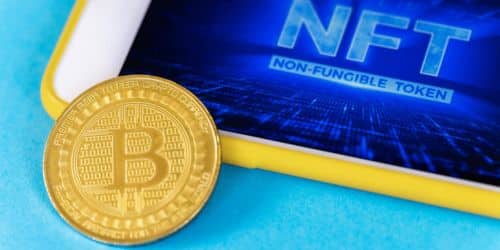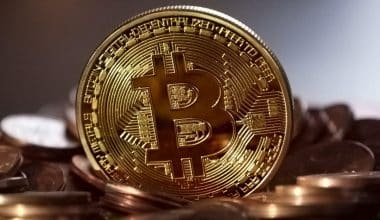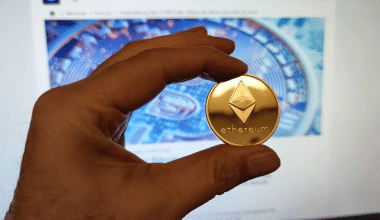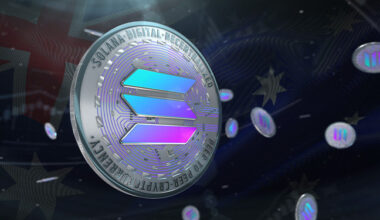NFTs are a relatively recent notion that emerged alongside the creation of the metaverse. NFT is an abbreviation for non-fungible token. Fungible assets are easily replaceable units in economics, such as money and currency.
For example, four American five-dollar bills may be exchanged for one American twenty-dollar bill, which would have the same value. Any non-fungible item, on the other hand, has distinct features that cannot be exchanged for anything else.
NFTs are assets that can be purchased or sold in the same way that any other thing or property can, but they are distinct intangible objects. They are digital assets that can be purchased, sold, and exchanged within the metaverse.
NFTs are not just one form; while they are not traditional art, they are now very much a part of the art world. But how can something digital and immaterial be considered art? Continue reading to learn more.
What Is An NFT?
Non-fungible tokens (NFTs) are assets that have been tokenized using blockchain technology. They are given unique identifying codes and metadata that set them apart from other tokens.
NFTs can be traded and swapped for money, cryptocurrencies, or other NFTs, depending on the market and owner value. For example, you could utilize an exchange to generate a token for a banana image. Some may spend millions on the NFT, while others may regard it as useless.
Tokens are also used for cryptocurrencies; however, the fundamental difference is that two coins from the same blockchain are interchangeable—they are fungible. Although two NFTs from the same blockchain may appear identical, they are not interchangeable.
The Evolution of NFTs
NFTs were developed decades before they became popular with the general public. According to reports, Kevin McKoy created and tokenized “Quantum” in 2014 on one blockchain (Namecoin), then minted and sold it on Ethereum in 2021.
NFTs are developed in accordance with the ERC-721 (Ethereum Request for Comment #721) standard, which governs how ownership is transmitted, transaction confirmation mechanisms, and how apps handle safe transfers (among other things). The ERC-1155 standard, which was ratified six months after ERC-721, enhances ERC-721 by batching many non-fungible tokens into a single contract, lowering transaction costs.
How Do NFTs Work?
NFTs are created by a process known as minting, in which the NFT’s information is recorded on a blockchain. At a high level, the minting procedure involves creating a new block, validating NFT information with a validator, and closing the block. This minting procedure frequently includes the incorporation of smart contracts that assign ownership and control the NFT’s transferability.
Tokens are issued with a unique identification that is directly connected to a blockchain address. Each token has an owner, and the owner’s information (i.e., the address where the minted token is kept) is public. Even if 5,000 NFTs of the same object are minted (similar to movie tickets), each token has a unique identity and can be differentiated from the others.
Fungibility and Blockchain
From a financial standpoint, cryptocurrencies, like actual money, are usually fungible, which means they may be sold or exchanged for one another. For example, on a particular market, one bitcoin is always worth the same as another bitcoin, just as every dollar bill in the United States has an implied exchange value of $1. Because of their fungibility, cryptocurrencies are appropriate as a safe means of trade in the digital economy.
As a result, NFTs alter the crypto paradigm by making each token unique and irreplaceable, rendering one non-fungible token “equal” to another. They are digital representations of assets that have been compared to digital passports since each token carries a unique, non-transferable identity that allows it to be distinguished from other tokens. They are also extendable, which means you may combine one NFT with another to form a third, distinct NFT.
The Advantages of Non-Fungible Tokens
The most obvious advantage of NFTs is market efficiency. Tokenizing a physical commodity can help speed sales procedures and eliminate the need for intermediaries. NFTs on a blockchain representing digital or physical artwork can eliminate the need for agents and allow merchants to interact directly with their target audiences (provided the artists know how to securely host their NFTs).
Investing
NFTs can also be used to simplify investments. Ernst & Young, for example, has already developed an NFT solution for one of its fine wine investors, keeping wine in a safe environment and utilizing NFTs to protect provenance.
Real estate can also be tokenized, which means that a property can be divided into several portions, each with its own set of features. For example, one area may be near a lake, while another is closer to the forest. Each piece of land may be distinct, priced differently, and represented by an NFT depending on its features. By combining relevant metadata into a distinctive NFT that is only associated with the relevant section of the property, it may be possible to speed up the challenging and bureaucratic process of real estate dealing.
NFTs, like stocks, can reflect ownership in a corporation; in fact, stock ownership is currently documented through ledgers that include information such as the stockholder’s name, date of issuance, certificate number, and number of shares. Because a blockchain is a distributed and secure ledger, issuing NFTs in the form of shares serves the same goal as issuing stocks. The fundamental benefit of combining NFTs and blockchain instead of a stock ledger is that smart contracts can automate ownership transfers—once an NFT share is sold, the blockchain can handle the rest.
Security
Non-fungible tokens can also help with identity security. Personal information, for example, saved on an immutable blockchain cannot be read, stolen, or used by anyone who does not have the keys.
By fractionalizing physical assets such as real estate, NFTs can help democratize investing. A digital real estate asset is considerably easier to divide among several owners than a physical one. That tokenization ethic does not have to be limited to real estate; it may also apply to other assets such as artwork. As a result, an artwork does not always have a single owner. Instead, many people can buy a piece of it, granting them ownership of a portion of the physical painting. Such arrangements could improve its value and revenue because more individuals can buy fragments of pricey art than whole pieces.
What Is An NFT Art?
NFT art, like any other NFT object, is digital art that has been tokenized on the blockchain. Because the artwork is totally digital, investors will ultimately buy, sell, and trade in the metaverse.
Just like there is only one original in physical art, there is only one original in NFT art. Despite the fact that it is reasonably easy to replicate with downloads and screenshots, only the original has unique value.
What Does NFT Art Mean for You?
Everyone will find something to their liking in the metaverse. While digital artwork is obviously more expensive for your digital wallet, viewing NFT artwork is just as accessible as viewing a physical piece of art at a museum.
NFT collections in the art market have developed as new artists emerge on a daily basis with works of art that appeal to people of all genres. Whether you enjoy traditional painting or are looking for a new medium, NFT art is definitely worth a look.
What Is NFT Minting?
To mint an NFT, digital data is converted into cryptographic collections or digital assets that are recorded on the blockchain. The digital products or files will be stored in a distributed ledger or decentralized database and will be impossible to edit, modify, or erase.
How Much Time Does It Take To Mint An NFT?
It’s difficult to predict how long it will take to mint NFTs. Almost all NFT platforms, tools, and marketplaces, on the other hand, make the NFT creation process simple.
Installing Metamask, an Ethereum wallet, as a browser chrome extension is the default step for creating an account or authenticating into the major NFT marketplaces.
Converting your digital content to NFT, presenting it to NFT markets, and advertising it for sale is analogous to uploading a video to YouTube, a music file to Spotify, or even selling a digital item or product for sale on Amazon, eBay, or Etsy.
Upload the file (PNG, JPG, GIF, MP3, or MP4), name it, add a description, set up royalties, and sell it.
Considerations Before Minting An NFT
Although minting NFT is simple on paper, there are a few things to consider before getting started. Minting is the process of converting digital art into a public record on the Ethereum blockchain. This is due to the fact that digital art would be impervious to modification and tampering. Minting refers to the process of adding NFTs to a blockchain in the same way that minting money refers to the process of creating currencies.
Make certain that your digital artwork is properly represented. NFT ensures that the artwork can be acquired or traded on the market in a variety of ways. It allows for ownership tracking as well as possible resale or collection flexibility. Finally, fundamental knowledge of NFTs can provide a reasonable sense of how to approach their development and representation.
Before minting an NFT, the following criteria must be considered:
#1. The Blockchain Platform
The first answer to the question “How do you mint an NFT?”” refers to the several blockchains that support the NFT token standard. Some of the more dependable solutions are as follows:
- Ethereum
- Polkadot
- Binance Smart Chain
- Tron
- EOS
- Tezos
- WAX
- Flow by Dapper Labs
- Cosmos
#2. The Nature of the NFT Ecosystem
The understanding of NFT features in the blockchain you select is the next critical factor to consider when looking for the most cost-effective way to mint NFT. It is critical to ensure that the platform you use can handle NFT transfers and sells across several blockchains. With each blockchain, developers should weigh the advantages and disadvantages of the NFT ecosystem.
#3. A Low-Cost Platform
Many ardent minters would attempt to create NFTs for the first time. As a result, people may be looking for a way to obtain an NFT for free. Popular options can be useful in these cases. The most popular blockchain systems for minting NFTs are now Binance Smart Chain and Ethereum. Because of their huge scale, these two platforms can operate as the largest NFT marketplaces while simultaneously giving additional visibility to buyers.
#4. The NFT Marketplace
Finally, choosing an NFT marketplace is the most important aspect before NFT minting. In the case of the Ethereum blockchain, developers may encounter a significant number of NFT platforms. Some well-known examples include Rarible, Mintable, and OpenSea. Furthermore, Juggerworld, Treasureland, and BakerySwap are Binance Smart Chain marketplaces.
How Do You Mint NFTs?
The most popular non-fungible token exchange is OpenSea. Users can buy and sell NFTs on the secondary market, as well as build and sell NFT collections on the main market.
On OpenSea, there are several procedures involved in minting NFTs. Begin by purchasing ETH, then create and connect a crypto wallet to your OpenSea account before uploading the digital file you will be creating as an NFT. The steps involved in minting an NFT on the OpenSea marketplace are outlined below.
#1. Buy Ethereum (ETH).
Ethereum is the second most popular cryptocurrency after Bitcoin. Many NFT marketplaces that use ETH to provide transaction services attest to its popularity. To purchase Ethereum, though, you must first register an account on one of your chosen trading platforms.
#2. Create Your Own Crypto Wallet
After purchasing some ETH, you will need to create a crypto wallet. The wallet will then be used to sell and acquire NFTs on OpenSea.
One of the most user-friendly wallets available is MetaMask. This wallet is also the most popular on OpenSea. Furthermore, once installed, you can use the wallet to store Ethereum-based tokens.
#3. Connect the cryptocurrency wallet to OpenSea.
You may now connect your newly formed wallet to OpenSea in a few simple steps:
- To unlock the MetaMask plugin, open it in your browser and enter your password.
- Go to OpenSea, the largest NFT marketplace, in the same browser, and choose “Profile.”
- Accept the terms and conditions in their entirety.
- Enter your email address and username to authenticate your account.
- You will be sent a confirmation email. Please follow the link.
What Is an NFT Marketplace?
An NFT marketplace allows you to buy and trade NFTs. There are numerous NFT marketplaces with a wide range of specialties and reputations. Before you start buying NFTs or selling your creations, do some research on which blockchain platform to employ.
How do NFT Games Work?
NFT games are not the same as simply keeping cryptocollectibles in your wallet. NFTs will be used in the rules, procedures, and player interactions of an NFT game. A game, for example, could use an NFT to represent your unique character or avatar. NFTs can also be found in digital things found while playing the game. You can then swap or trade your NFTs for profit with other gamers.
So, how do you technically integrate NFTs in a game environment? Developers build smart contracts that make up the rules for the NFTs used to trade, produce, and implement NFTs within a game. Smart contracts are pieces of code that run on their own and are stored on a blockchain.
What are NFT Play-to-earn Games?
Play-to-earn NFT games allow users to produce an income stream by playing. A player is typically rewarded with tokens and, on occasion, NFTs, earning more the longer they play. Tokens are frequently required as part of the game’s crafting process.
The token technique is usually the more consistent of the two because tokens can be gained continuously through play, whereas NFT drops are more random. Users in low-income nations have found play-to-earn to be especially attractive as an alternative or supplement to fixed income or social security.
How Do NFT Games Make Money?
The rules of the game and market demand determine how much money you can make playing an NFT game. You will earn money from other players who value the NFTs or cryptocurrencies gained in the game. You must pay out by selling your items on a market, exchange, or auction house. Value in NFT games is determined from the NFT or token’s collectability or in-game utility. These two elements can give rise to supposition.
Can I Lose Money if I Play NFT Games?
It is possible to lose money when participating in NFT games. The exact number depends on the type of game, its mechanics, and the worth of the NFTs you’re dealing with. Losing money does not always imply that you are being duped. Because NFTs are speculative and their value is determined by market forces, your losses are likewise determined by market forces. As with any other cryptocurrency investment, only spend what you can afford to lose.
What Exactly Does NFT Do?
What is the purpose of NFTs? NFTs are tokens that are used to indicate ownership of one-of-a-kind objects. NFTs enable their developers to tokenize items such as art, valuables, and even real estate. The Ethereum blockchain secures them, and they can only have one official owner at a time.
How Does An NFT Make Money?
At their essence, NFTs are smart contracts, which are bits of software on a blockchain. It is possible to embed code in an NFT smart contract that pays the inventor some cryptocurrency each time it is sold. This is commonly referred to as royalty. Many NFT markets have a royalty cap of 10%.
How Do I Invest and Make Money With NFT?
Making money with NFTs involves some planning and patience. Buying low and selling high is one strategy to benefit. You can invest in undervalued NFTs and hold them until their value rises. Another method to benefit is to produce valuable NFTs in great demand.
Is an NFT A Currency?
Non-fungible Tokens (NFTs) are a type of cryptocurrency that represents a one-of-a-kind digital asset or a one-of-a-kind piece of artwork. Fiat and cryptocurrencies are mostly used for transactions and are fungible, which means that each unit may be exchanged for another.
In Conclusion
Non-fungible tokens are a development of cryptocurrency’s very straightforward premise. Modern financial systems are made up of complex trading and financing systems for many asset kinds, such as real estate, lending contracts, and artwork. NFTs advance the reconfiguration of this infrastructure by enabling digital representations of assets.
To be sure, neither the concept of digital representations of physical goods nor the application of unique identification is revolutionary. When these ideas are paired with the advantages of a tamper-resistant blockchain, smart contracts, and automation, they constitute a powerful force for change.
- Best Ways To Get Free NFT Drops
- Blockchain and the Art World NFTs, Authentication, and Ownership
- Understanding the NFT Hype
- Big News: Amazon Plans To Enter The NFT Market






